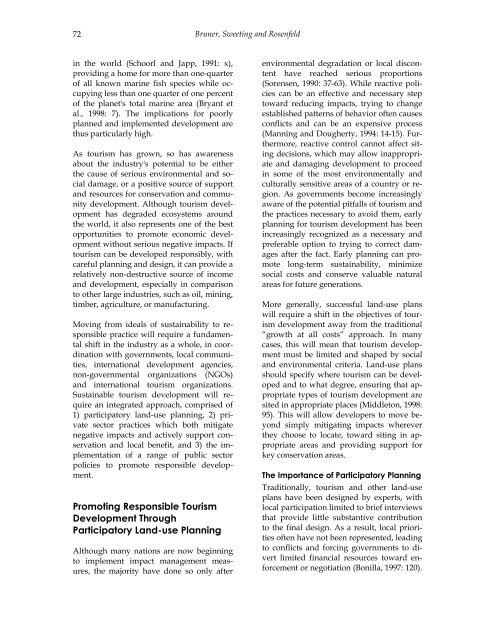THE GREEN HOST EFFECT: AN INTEGRATED APPROACH TO ...
THE GREEN HOST EFFECT: AN INTEGRATED APPROACH TO ...
THE GREEN HOST EFFECT: AN INTEGRATED APPROACH TO ...
You also want an ePaper? Increase the reach of your titles
YUMPU automatically turns print PDFs into web optimized ePapers that Google loves.
72<br />
in the world (Schoorl and Japp, 1991: x),<br />
providing a home for more than one-quarter<br />
of all known marine fish species while occupying<br />
less than one quarter of one percent<br />
of the planet's total marine area (Bryant et<br />
al., 1998: 7). The implications for poorly<br />
planned and implemented development are<br />
thus particularly high.<br />
As tourism has grown, so has awareness<br />
about the industry's potential to be either<br />
the cause of serious environmental and social<br />
damage, or a positive source of support<br />
and resources for conservation and community<br />
development. Although tourism development<br />
has degraded ecosystems around<br />
the world, it also represents one of the best<br />
opportunities to promote economic development<br />
without serious negative impacts. If<br />
tourism can be developed responsibly, with<br />
careful planning and design, it can provide a<br />
relatively non-destructive source of income<br />
and development, especially in comparison<br />
to other large industries, such as oil, mining,<br />
timber, agriculture, or manufacturing.<br />
Moving from ideals of sustainability to responsible<br />
practice will require a fundamental<br />
shift in the industry as a whole, in coordination<br />
with governments, local communities,<br />
international development agencies,<br />
non-governmental organizations (NGOs)<br />
and international tourism organizations.<br />
Sustainable tourism development will require<br />
an integrated approach, comprised of<br />
1) participatory land-use planning, 2) private<br />
sector practices which both mitigate<br />
negative impacts and actively support conservation<br />
and local benefit, and 3) the implementation<br />
of a range of public sector<br />
policies to promote responsible development.<br />
Promoting Responsible Tourism<br />
Development Through<br />
Participatory Land-use Planning<br />
Although many nations are now beginning<br />
to implement impact management measures,<br />
the majority have done so only after<br />
Bruner, Sweeting and Rosenfeld<br />
environmental degradation or local discontent<br />
have reached serious proportions<br />
(Sorensen, 1990: 37-63). While reactive policies<br />
can be an effective and necessary step<br />
toward reducing impacts, trying to change<br />
established patterns of behavior often causes<br />
conflicts and can be an expensive process<br />
(Manning and Dougherty, 1994: 14-15). Furthermore,<br />
reactive control cannot affect siting<br />
decisions, which may allow inappropriate<br />
and damaging development to proceed<br />
in some of the most environmentally and<br />
culturally sensitive areas of a country or region.<br />
As governments become increasingly<br />
aware of the potential pitfalls of tourism and<br />
the practices necessary to avoid them, early<br />
planning for tourism development has been<br />
increasingly recognized as a necessary and<br />
preferable option to trying to correct damages<br />
after the fact. Early planning can promote<br />
long-term sustainability, minimize<br />
social costs and conserve valuable natural<br />
areas for future generations.<br />
More generally, successful land-use plans<br />
will require a shift in the objectives of tourism<br />
development away from the traditional<br />
“growth at all costs” approach. In many<br />
cases, this will mean that tourism development<br />
must be limited and shaped by social<br />
and environmental criteria. Land-use plans<br />
should specify where tourism can be developed<br />
and to what degree, ensuring that appropriate<br />
types of tourism development are<br />
sited in appropriate places (Middleton, 1998:<br />
95). This will allow developers to move beyond<br />
simply mitigating impacts wherever<br />
they choose to locate, toward siting in appropriate<br />
areas and providing support for<br />
key conservation areas.<br />
The Importance of Participatory Planning<br />
Traditionally, tourism and other land-use<br />
plans have been designed by experts, with<br />
local participation limited to brief interviews<br />
that provide little substantive contribution<br />
to the final design. As a result, local priorities<br />
often have not been represented, leading<br />
to conflicts and forcing governments to divert<br />
limited financial resources toward enforcement<br />
or negotiation (Bonilla, 1997: 120).















